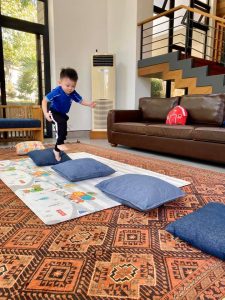Tummy time is something many of us parents have already encountered from books, social media, and/or our children’s pedia. But how important is this really, and how does this help our babies develop? In this blog, we answer these questions, identify tummy time benefits, as well as provide you with a list of activity suggestions to make tummy time a regular part of you and your baby’s daily routine.
So what is Tummy Time?
Tummy time is any time where your baby is awake and doing an activity while lying on his belly. It’s like your baby’s first exercise routine! Tummy time is important as it helps with:
- Prevention of a flat spot on the head or plagiocephaly
- Strengthening baby’s neck, core, trunk, and shoulder muscles
- Sensory stimulation necessary for body awareness
The strengthening and sensory experience tummy time brings will in turn lead to your baby acquiring more motor skills such as pushing up on all fours, rolling, crawling, sitting, and eventually standing and walking.
How do we get started with tummy time?
Did you know that tummy time can be done as early as when your baby is just a few days old? Maybe you’ve already started practising it, although you may not be fully aware you’re already doing tummy time.
Whenever you put your baby over your chest as you recline on the sofa or you breastfeed your baby in a laid back position, you are already doing valuable tummy time with your little one! Here’s what it looks like:


Several times a day of this, broken down into short bursts of time, is all your baby needs in his first few weeks. There is no pressure to “perform” or “exercise”. All you and your child need to do is bond, feel each other’s warmth, feed (if you’re breastfeeding), and simply be close. All of those things give your baby the sensory stimulation he needs to better understand this new world he is in and the momma he is with.
Tummy time progression
As weeks turn to months, your little one will soon start to be more curious of his surroundings. Grab this perfect opportunity to do more tummy time with your little one. Here are a few suggestions you can try:
- On a mat on the floor: Place several toys or books in front or in an arc in front of your baby so he can also practice moving his head side to side to look around. Placing a mirror in front will also help encourage your baby to lift his head up.


- On your lap: This is an easier position for the baby as the slight incline allows him to lift his head with less resistance from gravity.
- On an exercise ball: Placing your little one on his belly over the ball and doing small bounces and rolling forward and back can also be great tummy time exercises! Not only does this give the basic benefits of tummy time, but the movement input is also both stimulating and calming for your baby.
- On your chest: This position is best for encouraging eye contact, facial recognition, and imitating facial expressions.
- Bonus: On your legs: And then do the airplane!!! This allows your baby to also practice righting reactions, moving their head and body back towards the middle. This position is best done when your baby is showing better neck control.

Tummy time requires no fancy toys or equipment. All you need is a firm surface, your body, your soothing/playful voice, and your baby. Create funny faces and use this as your baby’s attraction. For me and my baby, our family pet, a mirror, colorful books, and an attractive-looking blanket helped a lot!
Still, do keep in mind that some babies may find this “work out” challenging and therefore resist being in the position. If this is the case, please listen to your baby and adjust your activity as he/she can better tolerate. Here are some ways you can do that.
- Increasing the incline of the surface where your baby is at: This may be on your legs, on your chest, etc. By positioning your baby’s upper body slightly higher, your baby is more able to lift his head or push himself up without having to go against too much gravity.
- Decrease duration: You can start with only 1-2 minutes, multiple times a day. And then eventually increase it to 3-5 minutes as your baby becomes more comfortable with the position.
- Putting a rolled up towel or thin blanket under your baby’s chest: This helps support your child’s upper body as he props his elbow on the mat. In this position, be sure to provide support on your baby’s hips by keeping it down on the surface. Do this to avoid your baby from falling forward flat on his face!
Remember, doing tummy time not only strengthens your child’s muscles, but also allows you to bond closely with your little one. Soon, once your baby starts to become more active, it will be time to level up from tummy time to more challenging core exercises.
Watch out for my next blog about core exercises for bigger babies and toddlers. Here, I share with you how to progress your tummy time activities to more active core exercises once your little one becomes more mobile. I also have simple yet fun activities toddlers and young children can do at home simply with the use of basic everyday household objects.

If your child is showing some delays in skills development and you’re concerned, our occupational therapists can help! When you schedule a comprehensive OT assessment and OT sessions with us, our team of occupational therapists can thoroughly evaluate your child’s skills and create an intervention plan to address them.
With right and early support, your child can gain necessary building blocks to learn how to use his body for play and exploration. Before you know it, you’ll have an active kiddo excited and ready to take on the world!


